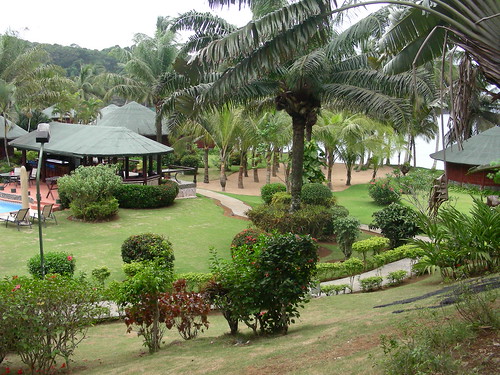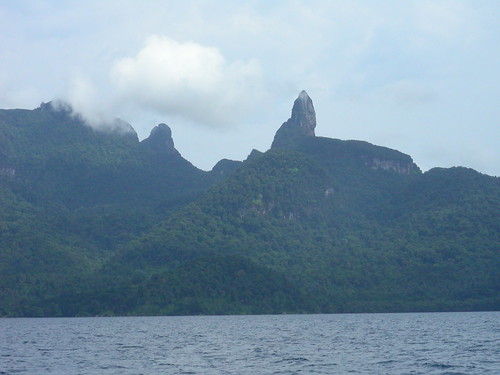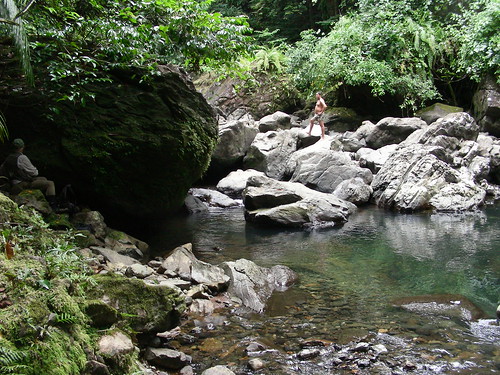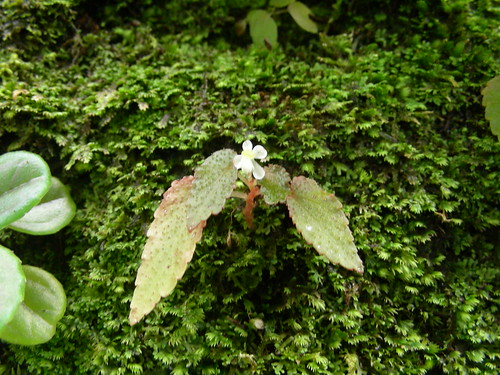It is probably not uncommon for many a field biologist to question himself about life choices he has made—like when he faces college tuitions, buying a new car… shouldn’t I have “gone for the bucks?,” the American Dream?” and so on. And then you get a 24 hour period like the one we just experienced, and it all becomes clear again. 
Bom Bom Turtle Hatchery. RCD phot. GG IV
The building to the far left in the picture above is called the pool bar (you can just see the swimming pool). Just beyond is an extension of sand which is confluent with the beach and cove beyond. There is 1 to 2” edge to the grass turf along this small beach extension. Since there are no tourists here at the moment the pool bar is where we scientists eat with the staff (you can see the barbecue). At 7:35 we were just finishing yet another wonderful Indian dinner cooked by Shyju, our chef (and friend from GG III), when there was a commotion right behind us in the sand and Attie, the young man who waits tables came dashing up to our table with a hatchling sea turtle. A whole nest of sea turtles had just hatched with 30 feet of our dinner table!

wrong-way hatchling. RCD phot. GG IV
Quick-witted Attie grabbed a plastic bucket, and we began racing around catching them, because it became clear almost immediately that the little critters were going the wrong way. They were heading toward the pool bar (and us) rather than down the sand to the ocean, only forty or so feet in the other direction. In fact the only thing that was keeping them within the sand area was the steepness (to them) of the grass/sand interface; otherwise, I have no doubt that eventually they would have all ended up in the swimming pool (saltwater, this year, luckily).

Attie's bucket of turtles. RCD phot. GG IV
We figure there were about 80 of them in the bucket, once we had them all. When, Attie took them down to edge of the surf and gently spread them out, they turned around, away from the ocean, and frantically made for the pool bar again. That’s when it became obvious that they were being attracted to the electric lights. So I stood in the surf, turned on my powerful halogen collecting light and that did the trick.. like little wind-up toys, they again all turned around again and paddled into the ocean..many swam past and brushed my feet… a wonderful tickly feeling I will never forget. I have no idea what species they were-- I would guess either greens or hawksbills.. definitely not leatherbacks…maybe I will be able to identify them from the few pictures and movies I took… In all of our travels, neither Jim, Tom nor I had ever seen this.. and it just happened one night on an Academy scientific expedition…

Phonolite towers, east coast, Principe. RCD phot. GG IV.
This morning we went by boat down the east coast of Principe to the southern end of the island; there are no roads on the southwestern exposures of any of the Gulf of Guinea islands because that’s the direction the weather comes from…and has for millions of years—and these areas are just too steep and dissected.. also the most poorly explored. As you can see from the image above, the east coast of Principe speaks for itself… this is truly an ancient island.

Our conveyance in fishing cove. RCD phot. GG IV
Our intention was to explore the Rio Sao Tome, scene of the disastrous boat flip incident during GG III, wherein all of our equipment got soaked (we’re talking cameras, recording stuff, cell phones, etc.) This time the skipper was a local Principean, Argentino who deposited us safely in a small protected cove, adjacent to a two-man fishing village (!)

Ramos at Rio Sao Tome, Principe. RCD Phot. GG IV.
Ramos (above) has been our constant guide and local naturalist on Principe throughout both GG III and GG IV. He appears frequently in earlier blogs. You are probably tired of reading about our bryophyte guy, Jim Shevock, going nuts, but he did again. We are up to over 600 collections (both islands), and recall that only 14 species of mosses have been recorded from the islands. Jim says he has tripled that number.
The high point was Tom’s discovery on a mossy vertical bank of a truly tiny begonia. what might be the smallest begonia in the world.

Begonia sp. perhaps smallest?. RCD phot. GG IV
Tom has no idea what species it is (or even if it has been described) but is thinking it might be the smallest begonia in the world; and wouldn’t that be somehow perfect?... we already know that the world’s largest species, B. baccata, is endemic to Sao Tome!
The last event of the day was a rather unique State visit. Unfortunately, we have no photos of this, but we knew that the President, Tose Cassandra, was fishing somewhere here today.. on our way up the coast, Argentino suddenly turned inland to a beach, and there was the President and a whole bunch of guys in the surf, some with beers. When we got to about 20 or 30 meters of the shore, Ramos jumped in and swam to join them. Mr. Cassandra was sitting on a cooler up in the shade. Suddenly he yelled “Bobi, Come!” So I dove in and joined the group for an informal summit… what are you gonna do?. A total kick. And, by the way, the other folks were his entire cabinet. Winding down now, here on Prince’s Island.
The Parting shot:

Shyju, master chef, at work. Weckerphoto. GG III
PARTNERS
We gratefully acknowledge the support of the G. Lindsay Field Research Fund, Hagey Research Venture Fund of the California Academy of Sciences, the Société de Conservation et Développement (SCD) and Africa’s Eden for logistics, ground transportation and lodging, STePUP of Sao Tome http://www.stepup.st/, Arlindo de Ceita Carvalho, Director General, and Victor Bomfim, Salvador Sousa Pontes and Danilo Barbero of the Ministry of Environment, Republic of São Tomé and Príncipe for permission to export specimens for study, the continued support of Bastien Loloumb of Monte Pico and Faustino Oliviera, Director of the botanical garden at Bom Sucesso. Special thanks for the generosity of private individuals, George G. Breed, Gerry F. Ohrstrom, Timothy M. Muller, Mrs. W. H. V. Brooke, Mr. and Mrs. Michael Murakami, Hon. Richard C. Livermore, Prof. & Mrs. Evan C. Evans III and Mr. and Mrs. Robert M. Taylor for helping make these expeditions possible. Our island work can be supported by donations to the California Academy of Sciences Gulf of Guinea Fund.